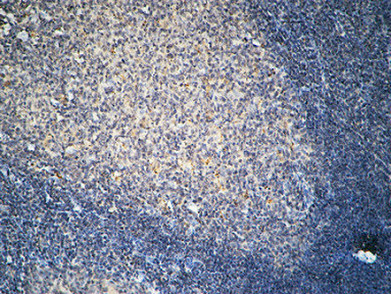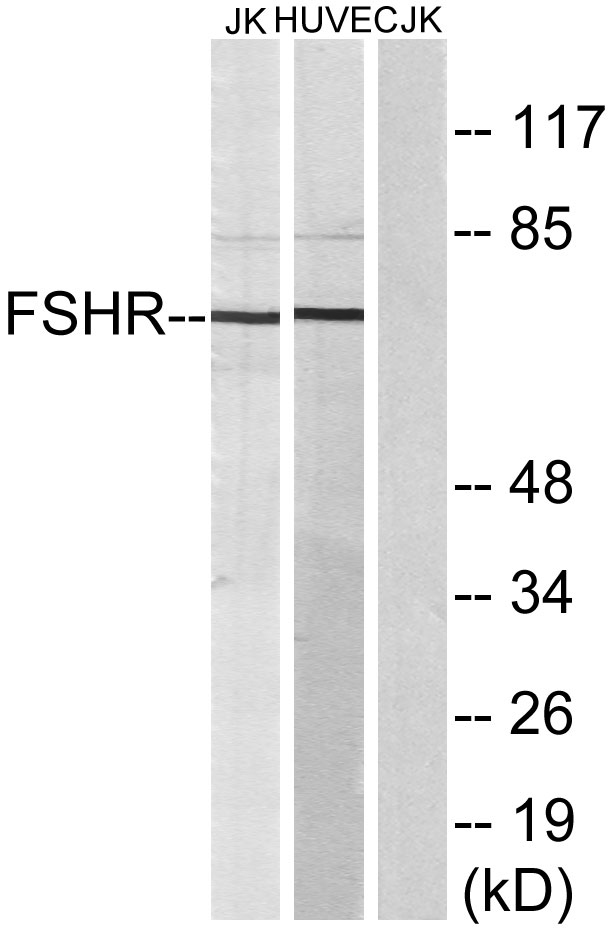FSHR Polyclonal Antibody
- Catalog No.:YT1795
- Applications:WB;IHC;IF;ELISA
- Reactivity:Human;Mouse;Rat
- Target:
- FSHR
- Fields:
- >>cAMP signaling pathway;>>Neuroactive ligand-receptor interaction;>>Ovarian steroidogenesis
- Gene Name:
- FSHR
- Protein Name:
- Follicle-stimulating hormone receptor
- Human Gene Id:
- 2492
- Human Swiss Prot No:
- P23945
- Mouse Gene Id:
- 14309
- Mouse Swiss Prot No:
- P35378
- Rat Gene Id:
- 25449
- Rat Swiss Prot No:
- P20395
- Immunogen:
- The antiserum was produced against synthesized peptide derived from human FSHR. AA range:211-260
- Specificity:
- FSHR Polyclonal Antibody detects endogenous levels of FSHR protein.
- Formulation:
- Liquid in PBS containing 50% glycerol, 0.5% BSA and 0.02% sodium azide.
- Source:
- Polyclonal, Rabbit,IgG
- Dilution:
- IHC: 100-300.WB 1:500 - 1:2000. ELISA: 1:5000.. IF 1:50-200
- Purification:
- The antibody was affinity-purified from rabbit antiserum by affinity-chromatography using epitope-specific immunogen.
- Concentration:
- 1 mg/ml
- Storage Stability:
- -15°C to -25°C/1 year(Do not lower than -25°C)
- Other Name:
- FSHR;LGR1;Follicle-stimulating hormone receptor;FSH-R;Follitropin receptor
- Observed Band(KD):
- 70kD
- Background:
- The protein encoded by this gene belongs to family 1 of G-protein coupled receptors. It is the receptor for follicle stimulating hormone and functions in gonad development. Mutations in this gene cause ovarian dysgenesis type 1, and also ovarian hyperstimulation syndrome. Alternative splicing results in multiple transcript variants. [provided by RefSeq, Mar 2010],
- Function:
- disease:Defects in FSHR are a cause of ovarian dysgenesis 1 (ODG1) [MIM:233300]; also known as premature ovarian failure or gonadal dysgenesis XX type or XX gonadal dysgenesis (XXGD) or hereditary hypergonadotropic ovarian failure or hypergonadotropic ovarian dysgenesis with normal karyotype. ODG1 is an autosomal recessive disease characterized by primary amenorrhea, variable development of secondary sex characteristics, and high serum levels of follicle-stimulating hormone (FSH) and luteinizing hormone (LH).,disease:Defects in FSHR are a cause of ovarian hyperstimulation syndrome (OHSS) [MIM:608115]. OHSS is a disorder which occurs either spontaneously or most often as an iatrogenic complication of ovarian stimulation treatments for in vitro fertilization. The clinical manifestations vary from abdominal distention and discomfort to potentially life-threatening, massive ovarian enlargeme
- Subcellular Location:
- Cell membrane ; Multi-pass membrane protein .
- Expression:
- Sertoli cells and ovarian granulosa cells.
Ginsenoside Rg1 improves fertility and reduces ovarian pathological damages in premature ovarian failure model of mice:. EXPERIMENTAL BIOLOGY AND MEDICINE Exp Biol Med. 2017;242(7):683-691 WB,IHC Mouse 1:100 ovaries
- June 19-2018
- WESTERN IMMUNOBLOTTING PROTOCOL
- June 19-2018
- IMMUNOHISTOCHEMISTRY-PARAFFIN PROTOCOL
- June 19-2018
- IMMUNOFLUORESCENCE PROTOCOL
- September 08-2020
- FLOW-CYTOMEYRT-PROTOCOL
- May 20-2022
- Cell-Based ELISA│解您多样本WB检测之困扰
- July 13-2018
- CELL-BASED-ELISA-PROTOCOL-FOR-ACETYL-PROTEIN
- July 13-2018
- CELL-BASED-ELISA-PROTOCOL-FOR-PHOSPHO-PROTEIN
- July 13-2018
- Antibody-FAQs
- Products Images

- Western Blot analysis of various cells using FSHR Polyclonal Antibody diluted at 1:1000
.jpg)
- Western Blot analysis of KB cells using FSHR Polyclonal Antibody diluted at 1:1000

- Immunohistochemical analysis of paraffin-embedded Human Amygdala. 1, Antibody was diluted at 1:100(4° overnight). 2, High-pressure and temperature EDTA, pH8.0 was used for antigen retrieval. 3,Secondary antibody was diluted at 1:200(room temperature, 30min).

- Western blot analysis of lysates from Jurkat and HUVEC cells, using FSHR Antibody. The lane on the right is blocked with the synthesized peptide.



